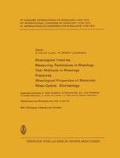Abstract
Crystalline polymers show a remarkable strain hardening in its plastic deformation compared with metals. In the case of metals, the power law holds between true stress and true strain, the power law index of which is lower than one (1). True stress tends to saturate with increasing true strain. Polymer chain shows very high modulus and high bonding energy along molecular axis, whereas intermolecular force is weak and the modulus perpendicular to the molecular axis is about one hundredth of that along molecular axis. With the progress of unfolding of molecular chains from folded structure in lamellar crystals, the deformation stress increases rapidly. To describe such a deformation process of crystalline polymers, it is especially necessary to employ true stress and true strain instead of nominal stress and nominal strain. In our previous paper (2), we have presented the equation to describe the true stress-strain relationship in a very simplified form, which was verified for linear polyethylene (HDPE) and nylon 6. In this paper, we have examined the applicability of our equation to isotactic polypropylene (PP), polyoxymethylene (POM) and polytetrafluoroethylene (PTFE).
Access this chapter
Tax calculation will be finalised at checkout
Purchases are for personal use only
Preview
Unable to display preview. Download preview PDF.
References
Ref. to Dieter, G., Mechanical Metallurgy, p. 247 (New York 1961).
Maruyama, S., K. Imada, and M. Takayanagi, Intern. J. Polymeric Mater. 1, 211 (1972).
Shimanouchi, T., M. Ashida, and S. Enomoto, J. Polymer Sci. 59, 93 (1962).
Geil, P. H., J. Polymer Sci. 44, 449 (1960).
Kojima, M., J. Polymer Sci. A-2, 5, 597 (1967).
Kajiyama, T., T. Okada, A. Sakoda, and M. Takayanagi, J. Macromol. Sci-Phys. B7(3), 583 (1973).
Peterlin, A., a) J. Polymer Sci., C (9), 61 (1965).
ibid., C (15), 427 (1967).
ibid, C (18), 123 (1967).
Peterlin, A., Kolloid-Z. u. Z. Polymere 216/217, 129 (1967).
Peterlin, A., Kolloid-Z. u. Z. Polymere, 233, 857 (1969).
Peterlin, A., Polymer Eng. & Sci. 8, 172 (1969).
Peterlin, A., Man made fibers (eds. Mark, Atlas, and Cernia), Vol. 1, p.283 (New York 1967).
Author information
Authors and Affiliations
Editor information
Editors and Affiliations
Rights and permissions
Copyright information
© 1975 Springer-Verlag Berlin Heidelberg
About this chapter
Cite this chapter
Takayanagi, M., Imada, K., Maruyama, S., Nakamura, K. (1975). General equation of stress-strain behavior in crystalline polymers. In: Vallet, G., Meskat, W. (eds) Rheological Theories · Measuring Techniques in Rheology Test Methods in Rheology · Fractures Rheological Properties of Materials · Rheo-Optics · Biorheology. Steinkopff, Heidelberg. https://doi.org/10.1007/978-3-662-41458-3_84
Download citation
DOI: https://doi.org/10.1007/978-3-662-41458-3_84
Publisher Name: Steinkopff, Heidelberg
Print ISBN: 978-3-7985-0424-0
Online ISBN: 978-3-662-41458-3
eBook Packages: Springer Book Archive

